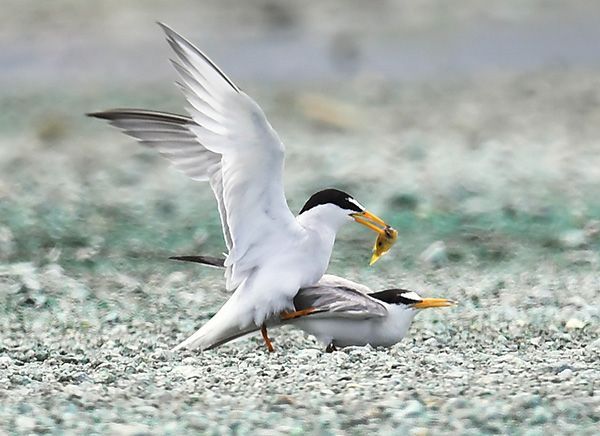Little terns: Nurturing love in material storage area

A male little tern courts a female (bottom) with a present of a small fish in his beak. (Morning of July 2, southern region of the Main Island. Photographed by John Matsumoto)
July 3, 2020 Ryukyu Shimpo
A group of little terns, an endangered migratory bird, are breeding in a material storage area located in the southern part of Okinawa’s main island. The area is managed by Naha City and Okinawa Prefecture. In recent years, the birds have increasingly been breeding in this kind of open space as a result of the diminishing coastline due to landfill work. In 2014, the Ministry of the Environment established guidance on the protection and care of little tern breeding grounds. The breeding season continues until late July, so officials of Naha City, which manages the land, are planning to hold off on any work that would affect the area.
According to the prefectural Nature Conservation Division, approximately 80 birds have been confirmed in the material storage area. On July 2, parent birds were seen warming their eggs and carrying food to their chicks. Males with fish in their beaks courting females and pairs of mating birds were also seen.
The Nature Conservation Division received word of the breeding terns from the Wild Bird Society of Okinawa in early June. The material storage area is managed by the prefecture, but because the city of Naha manages the land, word was sent to the city as well. According to city representatives, there are plans to begin work such as enclosing the area and hydroseeding to prevent red soil runoff starting in August, but “we will see what is happening with the birds as we consider the timing.”
According to the chair of the Wild Bird Society of Okinawa, Masakuni Yamashiro, the little terns were observed breeding in the same location several years ago. “When you can predict that birds will nest in an area like this, you need to think carefully about a proactive response. Since the Ministry of the Environment released the guidance, the governmental response has improved,” he says. “If people get too close to the area, the breeding season can be a failure. I would like for people to leave the area alone.”
(English translation by T&CT and Ellen Huntley)
Previous Article:Journal details Okinawan residents being “ordered to leave cave shelters” by the Japanese army during the United States army’s assault in the Battle of Okinawa
Next Article:Woman who spoke about the Battle of Okinawa as the “Trembling Girl” harassed at home by unknown male visitor
[Similar Articles]
- Over 30,000 grey-faced buzzards fly to Miyako
- Two male Okinawa rails killed by cars in Kunigami
- Okinawa woodpecker habitats move south to Nago area
- Endangered birds fly on Oura Bay
- Road accidents involving Yambaru kuina hit record high
 Webcam(Kokusai Street)
Webcam(Kokusai Street)


